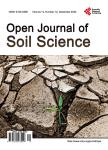Biochemical Fractionation of Soil Organic Matter after Incorporation of Organic Residues
Biochemical Fractionation of Soil Organic Matter after Incorporation of Organic Residues作者机构:Department of Soils and Agrifood Engineering Université Laval Québec Canada
出 版 物:《Open Journal of Soil Science》 (土壤科学期刊(英文))
年 卷 期:2015年第5卷第6期
页 面:135-143页
学科分类:1002[医学-临床医学] 100214[医学-肿瘤学] 10[医学]
主 题:Soil Organic Matter Van Soest Holocellulose Lignin Compositional Data Analysis
摘 要:Soil organic matter (SOM) is a key factor for building and maintaining soil quality. The SOM quality is commonly assessed using densitometric and sieving separation methods, but such methods do not inform on the biochemical composition of SOM. Our objective was to evaluate the van Soest extraction procedure for soluble (SOL), holocellulose (HOLO) and lignin/cutin (LIC) fractions of SOM after incorporating crop residues and animal wastes into a C-depleted loamy sand. Millet cuttings, oat straw, fresh cattle manure and cattle manure compost were dried, sieved to obtain 53 - 250 and 250 - 2000 μm size fractions and characterized biochemically using a modified NDF-ADF-ADL van Soest method. Soil was also sieved into 53 - 250 and 250 - 2000 μm fractions. On a dry mass basis, crop residues contained 60% - 70% holocellulose while animal wastes contained more than 40% ash. Each soil fraction was combined with three rates of the corresponding organic fraction (2, 4, and 6 Mg·haǃ millet forage cuttings or oat straw and 5, 10, and 15 Mg·haǃ of cattle manure or cattle manure compost). Changes in soil biochemical components were analyzed using the balance method of compositional data analysis. Amendment, application rate and size fraction influenced significantly (p 0.05) the [SOL | HOLO] balance but did not significantly affect the [SOL,HOLO | LIC] balance. The [SOL | HOLO] increased linearly with addition rate of crop residues, and decreased linearly with addition rate of animal wastes. This approach of balancing biochemical SOM components is a promising method to monitor the changes in SOM quality after the incorporation of organic residues and to elaborate beneficial practices for managing crop residues and animal wastes in agro-ecosystems.




